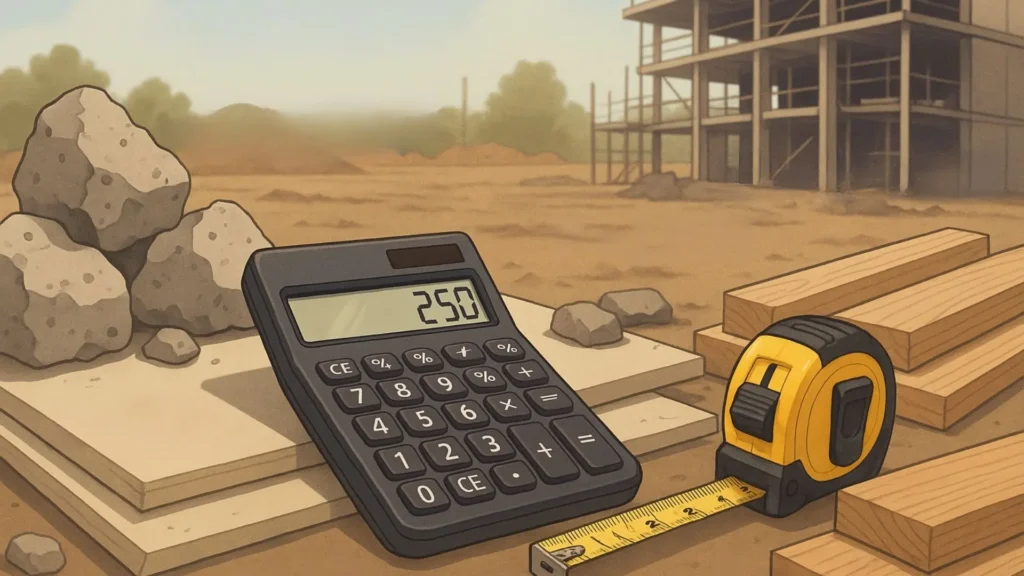You calculate construction and demolition waste by measuring your project dimensions in cubic feet, then dividing by 27 to get cubic yards – but here’s the game-changer most people miss: you multiply by 0.33 to account for airspace in debris. This one formula prevents costly mistakes that plague 90% of DIY projects.

The Real Construction and Demolition Waste Calculation Formula
Forget everything you think you know about calculating demolition waste. Most online “experts” are giving you garbage formulas that’ll cost you hundreds in overage fees or leave you scrambling for additional dumpsters mid-project. Here’s the truth that professional contractors use:
**The Master Formula:** Length (ft) × Width (ft) × Height (ft) × 0.33 ÷ 27 = Cubic Yards Needed
That 0.33 factor? It’s pure gold. Demolition debris isn’t solid like a block of cheese – it’s got airspace, gaps, and irregular shapes. Skip this adjustment and you’ll either way over-order (wasting money) or way under-order (creating project delays that cost even more).
| Project Example | Dimensions | Raw Calculation | With Airspace Factor |
|---|---|---|---|
| Kitchen Demo | 15′ × 12′ × 8′ | 1,440 ÷ 27 = 53.3 cu yards | 1,440 × 0.33 ÷ 27 = 17.6 cu yards |
| Bathroom Gut | 8′ × 10′ × 8′ | 640 ÷ 27 = 23.7 cu yards | 640 × 0.33 ÷ 27 = 7.8 cu yards |
| Basement Cleanout | 30′ × 20′ × 8′ | 4,800 ÷ 27 = 177.8 cu yards | 4,800 × 0.33 ÷ 27 = 58.7 cu yards |
| Whole House Demo | 40′ × 30′ × 10′ | 12,000 ÷ 27 = 444.4 cu yards | 12,000 × 0.33 ÷ 27 = 146.7 cu yards |
The Dumpster Size Selection System That Actually Works
Why Volume Calculations Fail Without Weight Considerations
Here’s where most people crash and burn: they calculate volume perfectly but completely ignore weight limits. A 20-yard dumpster might seem perfect for your calculated 18 cubic yards of concrete debris, but concrete weighs 3,000-4,000 pounds per cubic yard. That 20-yard container maxes out at about 4-6 tons total.
Do the math: 18 cubic yards × 3,500 pounds = 63,000 pounds (31.5 tons). You’d need SIX 20-yard dumpsters to handle the weight, even though the volume suggests you only need one. This is why amateurs get hammered with overage fees.
The Professional Contractor’s Dumpster Sizing Chart
Smart contractors don’t guess – they use this proven sizing system that accounts for both volume and weight limitations. Study this chart like your profit margins depend on it (because they do):
| Dumpster Size | Volume Capacity | Weight Limit | Best Material Types |
|---|---|---|---|
| 10 Yard | 10 cubic yards | 1-2 tons | Light debris, drywall, wood |
| 15 Yard | 15 cubic yards | 2-3 tons | Small renovations, mixed debris |
| 20 Yard | 20 cubic yards | 3-4 tons | Roofing, flooring, medium projects |
| 30 Yard | 30 cubic yards | 4-5 tons | Large renovations, new construction |
| 40 Yard | 40 cubic yards | 5-6 tons | Major demolition, commercial projects |
Material-Specific Calculation Strategies
Concrete and Heavy Materials: The Weight-First Approach
When you’re dealing with concrete, brick, or stone, flip the script. Calculate weight first, volume second. Here’s the insider method:
Concrete demolition: Measure area × thickness × 150 pounds per cubic foot = total weight. Then divide by your dumpster’s weight limit (not volume limit) to determine how many containers you need. A 4-inch thick concrete patio that’s 20′ × 30′ weighs about 30,000 pounds – that’s 15 tons requiring multiple dumpster loads regardless of volume.
Mixed Debris: The Contractor’s Secret Formula
Mixed construction debris is tricky because materials don’t pack efficiently together. Professional contractors add a 20-30% “inefficiency factor” to their volume calculations. If your math says 20 cubic yards, order 25-26 cubic yards of capacity to account for irregular packing.
This seemingly “wasteful” approach actually saves money by preventing the need for emergency additional pickups that cost 2-3 times normal rates. Smart money thinks ahead.
| Material Type | Pounds per Cubic Yard | Calculation Priority | Packing Efficiency |
|---|---|---|---|
| Concrete/Masonry | 3,000-4,000 lbs | Weight limit first | 85% (dense packing) |
| Drywall | 500-800 lbs | Volume capacity | 70% (irregular shapes) |
| Wood/Lumber | 400-700 lbs | Volume capacity | 60% (lots of airspace) |
| Mixed Debris | 800-1,200 lbs | Balance both factors | 50% (very inefficient) |
Project-Specific Calculation Methods
Room Demolition: The Square Footage Shortcut
For interior demolition, experienced contractors use these proven square footage multipliers that account for typical ceiling heights and material densities:
**Kitchen gut job:** Square footage × 0.5 = cubic yards needed
**Bathroom demo:** Square footage × 0.8 = cubic yards needed
**Living space renovation:** Square footage × 0.3 = cubic yards needed
These multipliers already include the airspace factor and typical material weights, making them incredibly accurate for planning purposes.
Whole House Demolition: The Professional Formula
Complete house demolition follows different rules because you’re dealing with structural elements, utilities, and foundation materials. The pro formula: Total square footage × 4 = cubic yards of debris expected.
A 1,500 square foot house generates approximately 6,000 cubic yards of debris – but remember, this includes heavy concrete foundation material that may max out weight limits long before volume limits.
The Multiple Dumpster Strategy
When One Container Isn’t Enough
Large projects require multiple dumpster loads, and timing is everything. Calculate your total debris volume, then divide by your chosen dumpster size. Always round UP to avoid the nightmare scenario of running out of disposal capacity with debris still to remove.
Example: 244 cubic yards of total debris ÷ 14-yard dumpster capacity = 17.4 dumpsters needed. Round up to 18 dumpsters to avoid headaches.
**HERE’S THE CRITICAL PART MOST PEOPLE MISS:** Don’t try to coordinate 18 different dumpster deliveries and pickups yourself. One missed pickup creates a domino effect that can shut down your entire project.
STOP WASTING TIME AND MONEY: If you’re dealing with a project requiring multiple dumpsters or complex waste calculations, why are you trying to figure this out yourself?
The professionals at Zap Dumpsters Peoria can get you waste disposal solutions appropriate to the task. One phone call to (309) 650-8954 gets you expert sizing recommendations that prevent costly mistakes. Trust someone who knows what works in the Peoria area.
Advanced Calculation Techniques
The Pre-Demolition Assessment Method
Smart contractors don’t rely on guesswork. They conduct systematic pre-demolition assessments that identify hidden materials, structural complications, and disposal challenges before they become expensive problems.
Walk through your project area with a measuring tape and camera. Document wall thicknesses, flooring layers, ceiling types, and any unusual construction features. These details dramatically affect waste calculations and disposal requirements.
Building Code and Construction Era Factors
Different construction eras used different building methods that affect waste calculations. Pre-1950 homes often have plaster walls, solid wood trim, and dense hardwood floors that create more debris per square foot. Modern construction with drywall and engineered materials generates less waste but may include materials requiring special disposal.
| Construction Era | Typical Materials | Waste Factor Adjustment | Special Considerations |
|---|---|---|---|
| Pre-1950 | Plaster, solid wood, heavy materials | Add 25% to standard calculations | Potential lead paint, asbestos |
| 1950-1980 | Mix of old and new methods | Standard calculations apply | Possible asbestos in insulation |
| 1980-Present | Drywall, engineered materials | Reduce by 10-15% | Lighter but bulkier materials |
Common Calculation Errors That Cost Money
The “Eyeball Method” Disaster
The biggest mistake? Guessing instead of measuring. “It looks like about a 20-yard dumpster worth” has cost more contractors more money than any other single error. Materials are deceptive – what looks like 15 cubic yards might actually be 30 cubic yards when properly calculated.
Always measure. Always calculate. Always add your safety margin. This systematic approach separates profitable contractors from broke ones.
Ignoring Local Disposal Regulations
Different areas have different rules about what can go in C&D dumpsters and how materials must be separated. Some locations require concrete to be disposed of separately from mixed debris. Others have restrictions on wood with nails or metal attachments.
These regulations affect your calculations because separated materials often require multiple containers instead of one large mixed-load container. Factor these requirements into your planning to avoid project delays and additional costs.
Professional Tools and Resources
Industry professionals use specialized software and calculation tools that account for local disposal options, material pricing, and weight restrictions. While these tools provide more accuracy than manual calculations, they require experience to use effectively.
Many waste management companies provide calculation assistance and project consultation as part of their service. This expertise often proves more valuable than trying to figure everything out yourself, especially for complex or large-scale projects.
Understanding the best way to dispose of construction debris helps inform your calculation approach and ensures you’re planning for the most efficient disposal methods available in your area.
Resources like house demolition calculators provide additional verification for your manual calculations, but remember that local conditions and disposal options significantly affect the accuracy of generic online tools.
The Safety Margin Strategy
Professional contractors always build safety margins into their waste calculations. Add 10-20% extra capacity to your calculated needs to account for unexpected materials, measurement errors, and packing inefficiencies.
This “extra” capacity costs less than emergency additional pickups or project delays caused by inadequate disposal planning. Smart money spends a little extra upfront to avoid major problems later.
When to Call the Professionals
Some projects are too complex or high-stakes for DIY calculations. Large commercial demolitions, projects involving hazardous materials, or jobs with tight timelines benefit from professional consultation and planning.
Professional construction and demolition waste services provide expertise that goes beyond simple volume calculations. They understand local disposal options, regulatory requirements, and cost optimization strategies that can save significant money on large projects.
THE BOTTOM LINE: You can spend hours researching formulas and second-guessing your calculations, or you can get it right the first time. Zap Dumpsters Peoria has calculated waste disposal for every type of project you can imagine. They know the local disposal facilities, understand weight and volume restrictions, and can size your containers perfectly the first time. Stop gambling with your project timeline and budget. Call (309) 650-8954 now and get professional sizing recommendations that eliminate guesswork and prevent costly mistakes.

Conclusion
Calculating construction and demolition waste accurately requires understanding the proper volume formula (Length × Width × Height × 0.33 ÷ 27), considering both weight and volume limitations, and factoring in material-specific characteristics. The most successful projects use systematic measurement, proven calculation methods, and professional guidance to ensure adequate disposal capacity while controlling costs. Remember to always add safety margins and consider local disposal regulations when planning your waste management strategy.
Construction and Demolition Waste Calculation FAQs
What’s the correct formula for calculating demolition debris volume?
The correct formula is: Length (ft) × Width (ft) × Height (ft) × 0.33 ÷ 27 = Cubic Yards. The 0.33 factor accounts for airspace in demolition debris, which isn’t solid throughout like new materials.
How do I know if I need multiple dumpsters for my project?
Calculate your total debris volume using the proper formula, then divide by your chosen dumpster size and round up. For example, 244 cubic yards ÷ 14-yard dumpster = 17.4, so you’d need 18 dumpster loads total.
Why do weight limits matter more than volume for some materials?
Heavy materials like concrete can max out a dumpster’s weight limit (typically 1-6 tons) long before filling the volume capacity. Concrete weighs 3,000-4,000 pounds per cubic yard, so weight calculations are more important than volume for these materials.

